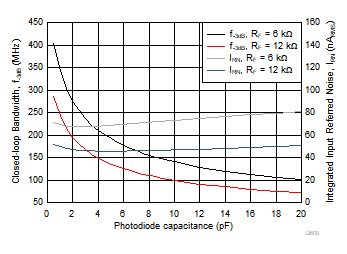SBOS622C July 2018 – January 2023 OPA855
PRODUCTION DATA
- 1 Features
- 2 Applications
- 3 Description
- 4 Revision History
- 5 Device Comparison Table
- 6 Pin Configuration and Functions
- 7 Specifications
- 8 Parameter Measurement Information
- 9 Detailed Description
- 10Application, Implementation, and Layout
- 11Device and Documentation Support
- 12Mechanical, Packaging, and Orderable Information
Package Options
Mechanical Data (Package|Pins)
- DSG|8
Thermal pad, mechanical data (Package|Pins)
- DSG|8
Orderable Information
3 Description
The OPA855 is a wideband, low-noise operational amplifier with bipolar inputs for wideband transimpedance and voltage amplifier applications. When the device is configured as a transimpedance amplifier (TIA), the 8-GHz gain bandwidth product (GBWP) enables high closed-loop bandwidths at transimpedance gains of up to tens of kΩs.
The following graph shows the bandwidth and noise performance of the OPA855 as a function of the photodiode capacitance when the amplifier is configured as a TIA. The total noise is calculated along a bandwidth range extending from DC to the calculated frequency (f) on the left scale. The OPA855 package has a feedback pin (FB) that simplifies the feedback network connection between the input and the output.
The OPA855 is optimized to operate in optical time-of-flight (ToF) systems where the OPA855 is used with time-to-digital converters, such as the TDC7201. Use the OPA855 to drive a high-speed analog-to-digital converter (ADC) in high-resolution LIDAR systems with a differential output amplifier, such as the THS4541 or LMH5401.
| PART NUMBER(1) | PACKAGE | BODY SIZE (NOM) |
|---|---|---|
| OPA855 | WSON (DSG, 8) | 2.00 mm × 2.00 mm |
 Photodiode Capacitance vs Bandwidth and
Noise
Photodiode Capacitance vs Bandwidth and
Noise